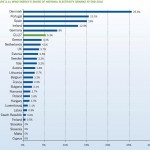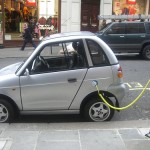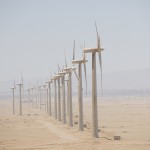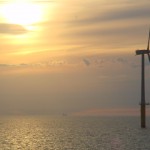 In 2010 wind power accounted 5.3% of the EU’s electricity demand, but this amount varies wildly from country to country across the continent. Denmark, Europe’s wind energy leader, is of course at the top of the table – wind power covers over one quarter of the country’s electricity demand. But the country in second position comes as a surprise. It’s not Germany or Spain, but Portugal – where wind energy accounts for an impressive 15.5% of the country’s electricity demand.
In 2010 wind power accounted 5.3% of the EU’s electricity demand, but this amount varies wildly from country to country across the continent. Denmark, Europe’s wind energy leader, is of course at the top of the table – wind power covers over one quarter of the country’s electricity demand. But the country in second position comes as a surprise. It’s not Germany or Spain, but Portugal – where wind energy accounts for an impressive 15.5% of the country’s electricity demand.
Most of Portugal’s wind power is located in the sparsely populated mountainous areas in the north-east of the country (all of its wind power is onshore). The country combines its wind energy with hydro power and some biomass to reach a level of 45% of electricity from renewable sources.
 A new report has found that wind power in Alberta, the Canadian province facing global criticism for its highly-polluting oil sands fossil fuel projects, could be the perfect match for Plug-in Hybrid Electric Vehicles (PHEVs).
A new report has found that wind power in Alberta, the Canadian province facing global criticism for its highly-polluting oil sands fossil fuel projects, could be the perfect match for Plug-in Hybrid Electric Vehicles (PHEVs).
Wind turbines create more power at night, when winds tend to be stronger in Alberta. Meanwhile most commuters do not drive at night so that is when they could charge their cars. If grid operators in Alberta could divert more wind energy for recharging electric cars at night then significant energy and emissions savings would result, the report noted.
Blackstone, one of the world’s largest asset management and private equity firms, are investing in the Meerwind Offshore Wind farm in Germany. They’ve written a guest post for the EWEA blog on why they chose to do this….
By: Sean Klimczak, Managing Director in the Private Equity Group, Blackstone
 Earlier this month, Blackstone, leading investment and advisory firm, announced the financial closing for “Meerwind,” the largest German offshore wind farm to complete its full financing process.
Earlier this month, Blackstone, leading investment and advisory firm, announced the financial closing for “Meerwind,” the largest German offshore wind farm to complete its full financing process.
The Meerwind project was made possible by the German regulatory framework for offshore wind, which is one of the best designed and practical renewable programs in the world. Meerwind is the first project to close under the recently unveiled KfW-sponsored Offshore Wind Programme. This visionary program, developed by the German government, is designed to help replace the ~25,000 megawatts of power needed as a result of the recent announcement that Germany is retiring its entire fleet of nuclear power plants by 2022 in the wake of the Fukushima nuclear tragedy in Japan.
 Wind power is expected to dominate Africa’s renewable energy sector over the next decade as the continent faces a massive struggle of providing electricity to remote communities, according to a new report by a global consultancy.
Wind power is expected to dominate Africa’s renewable energy sector over the next decade as the continent faces a massive struggle of providing electricity to remote communities, according to a new report by a global consultancy.
A Frost & Sullivan press release issued on Wednesday noted that the total renewable power investment in Africa, which was €2.5 billion by 2010, is expected to grow to €40 billion by the end of this decade.
“The key growth sectors will be wind power, solar power, geothermal power and foreign direct investment (FDI) into energy and power infrastructure,” the release quoted Ross Bruton, Frost & Sullivan’s energy and power systems industry analyst, as saying.
The release noted that Africa is the most poorly electrified continent in the world even though it has enough energy resources to more than adequately meet its existing and growing energy needs.
 On 11 March this year a devastating earthquake and tsunami struck the Pacific coast of Japan. Not only were over 15,000 deaths recorded, but according to Wikipedia over 4,000 people are still missing. It was Japan’s most powerful earthquake ever recorded, so powerful was it that the island of Honshu shifted eight feet to the east and the combined effect of the quake and tsunami caused the Fukushima nuclear plant to go into meltdown.
On 11 March this year a devastating earthquake and tsunami struck the Pacific coast of Japan. Not only were over 15,000 deaths recorded, but according to Wikipedia over 4,000 people are still missing. It was Japan’s most powerful earthquake ever recorded, so powerful was it that the island of Honshu shifted eight feet to the east and the combined effect of the quake and tsunami caused the Fukushima nuclear plant to go into meltdown.
While the full consequences of the nuclear accident remain unknown – the latest reports reveal that the planned cold shutdown of the plant by the end of this year has been delayed and that 35 of the country’s 54 nuclear plants are still offline – there is one positive story for Japan’s energy infrastructure: no wind turbines were destroyed by the earthquake.
 In 2010 wind power accounted 5.3% of the EU’s electricity demand, but this amount varies wildly from country to country across the continent. Denmark, Europe’s wind energy leader, is of course at the top of the table – wind power covers over one quarter of the country’s electricity demand. But the country in second position comes as a surprise. It’s not Germany or Spain, but Portugal – where wind energy accounts for an impressive 15.5% of the country’s electricity demand.
In 2010 wind power accounted 5.3% of the EU’s electricity demand, but this amount varies wildly from country to country across the continent. Denmark, Europe’s wind energy leader, is of course at the top of the table – wind power covers over one quarter of the country’s electricity demand. But the country in second position comes as a surprise. It’s not Germany or Spain, but Portugal – where wind energy accounts for an impressive 15.5% of the country’s electricity demand.






 Comments
Comments



